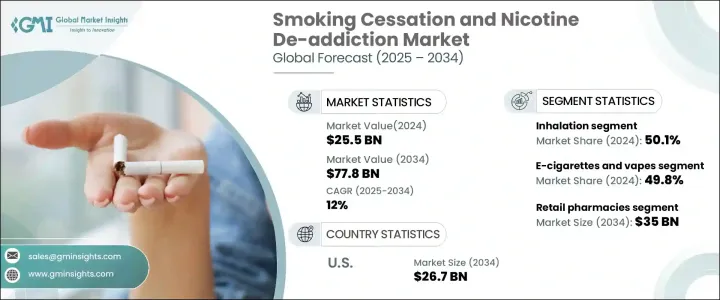
|
시장보고서
상품코드
1698265
금연 및 니코틴 중독 치료 시장 : 시장 기회, 성장 촉진요인, 산업 동향 분석, 예측(2025-2034년)Smoking Cessation and Nicotine De-addiction Market Opportunity, Growth Drivers, Industry Trend Analysis, and Forecast 2025-2034 |
||||||
세계의 금연 및 니코틴 중독 치료 시장은 2024년 255억 달러에 이르렀으며, 2025-2034년 연평균 복합 성장률(CAGR) 12%로 성장할 것으로 예측됩니다.
폐암, 심혈관질환, 호흡기질환 등 흡연에 따른 심각한 건강위험에 대한 의식이 높아지면서 니코틴 중독 치료 제품에 대한 수요를 촉진하고 있습니다. 금연 캠페인을 추진하는 정부의 대처, 담배 제품에 대한 규제 강화, 보다 건강한 대체품에 대한 소비자 기호의 고조는 시장 확대를 더욱 가속화시키고 있습니다.

금연 프로그램, 니코틴 대체 요법(NRT), 선진적인 약제 제제가 중시되어 시장은 향후 10년간 크게 성장할 전망입니다. 게다가 의약품 진보와 처방약 및 행동 지원 요법 등의 차세대 니코틴 대체 솔루션의 도입에 의해, 금연을 성공시키기 쉬워지고 있습니다. 금연 지원을 제공하는 디지털 헬스 플랫폼 및 모바일 애플리케이션의 채용이 증가하고 있는 것도, 이러한 솔루션의 인지도 및 접근성 향상에 한층 더 기여하고 있습니다.
| 시장 범위 | |
|---|---|
| 시작 연도 | 2024년 |
| 예측 연도 | 2025-2034년 |
| 시작 금액 | 255억 달러 |
| 예측 금액 | 778억 달러 |
| CAGR | 12% |
시장은 니코틴 대체요법(NRT), 약물요법, 전자담배 및 VAPE 등 제품 유형별로 분류됩니다. 2024년에는 전자담배 및 VAPE 부문이 시장의 대부분을 차지했으며, 전체 점유율의 50%를 차지했습니다. 이러한 대체품에 대한 기호 고조는, 기존의 담배에 비해 해가 적다고 인식되고 있는 것에 기인하고 있습니다. 특히 북미와 유럽의 젊은층이, 그 편리성, 다채로운 플레이버, 기술적 진보에 이끌려 VAPE 기기로의 시프트를 주도하고 있습니다. VAPE 제품에 의한 제어된 니코틴 전달에 대한 규제 당국의 승인 증가와 주요 기업에 의한 혁신적인 피해 경감 기술에 대한 투자의 증가가 이 분야의 성장을 더욱 뒷받침하고 있습니다.
시장을 투여경로별로 살펴보면 경구, 경피, 비강, 흡입, 설하의 각 방식으로 구분됩니다. 2024년 기준으로는 흡입법이 50%의 점유율을 차지했으며 시장을 선도했습니다. 이 부문의 우위성은 니코틴 흡입기, VAPE, 전자담배의 채택이 증가하고 있는 것에 크게 기인하고 있습니다. 흡입 기반 치료법이 지속적으로 발전함에 따라 제조사들은 니코틴 투여량을 조절할 수 있도록 설계된 새로운 니코틴 흡입기를 발표하고 있어 금연 보조제로서의 효과를 높이고 있습니다. 유해한 화학물질에 대한 노출을 최소화하면서 기존의 흡연체험을 재현할 수 있는 것이 흡입방식에 대한 소비자 기호의 원동력이 되고 있습니다.
미국의 금연 및 니코틴 중독 치료 시장은 2024년에는 89억 달러로 평가되었고, 2034년에는 267억 달러에 이를 것으로 예측됩니다. 미국에서는 폐암 및 기타 흡연 관련 질환의 유병률이 증가하고 있으며, 금연 보조 제품의 수요를 견인하고 있습니다. 흡연자의 증가, 특히 젊은 성인은 기존의 담배를 대체할 것을 적극적으로 요구하고 있어 NRT, 처방약, 행동요법의 수요 급증으로 이어지고 있습니다. 금연 이행 지원으로 전자담배와 VAPE가 널리 채택되고 있는 것이 시장의 성장을 더욱 뒷받침하고 있습니다. 연구 개발의 개척은 정부의 금연 이니셔티브의 뒷받침과 함께 향후 몇 년간 시장 기업에게 큰 비즈니스 기회를 가져다 줄 것으로 예상됩니다.
목차
제1장 조사 방법 및 조사 범위
제2장 주요 요약
제3장 업계 인사이트
- 생태계 분석
- 업계에 미치는 영향요인
- 성장 촉진요인
- 흡연에 수반하는 건강 리스크에 대한 의식 증가
- 정부의 규제 및 금연 캠페인
- 금연 보조제품의 진보
- 흡연 관련 질환 및 헬스케어 비용 증가
- 업계의 잠재적 위험 및 과제
- 금연 보조제품의 고비용
- 심리적 및 신체적 중독의 과제
- 성장 촉진요인
- 성장 가능성 분석
- 기술 상황
- 규제 상황
- 갭 분석
- 특허 분석
- Porter's Five Forces 분석
- PESTEL 분석
제4장 경쟁 구도
- 서문
- 기업 점유율 분석
- 기업 매트릭스 분석
- 주요 시장 기업의 경쟁 분석
- 경쟁 포지셔닝 매트릭스
- 전략 대시보드
제5장 시장 추계 및 예측 : 제품 유형별(2021-2034년)
- 주요 동향
- 니코틴 대체요법
- 니코틴 검
- 니코틴 패치
- 니코틴 로치
- 니코틴 점비약
- 니코틴 흡입기
- 약물요법
- 발레니클린(찬틱스)
- 부프로피온(자이반)
- 전자담배 및 VAPE
제6장 시장 추계 및 예측 : 투여 경로별(2021-2034년)
- 주요 동향
- 경구
- 경피
- 경비
- 흡입
- 설하
제7장 시장 추계 및 예측 : 유통 채널별(2021-2034년)
- 주요 동향
- 병원 약국
- 소매 약국
- 전자상거래
제8장 시장 추계 및 예측 : 지역별(2021-2034년)
- 주요 동향
- 북미
- 미국
- 캐나다
- 유럽
- 독일
- 영국
- 프랑스
- 스페인
- 이탈리아
- 네덜란드
- 아시아태평양
- 중국
- 일본
- 인도
- 호주
- 한국
- 라틴아메리카
- 브라질
- 멕시코
- 아르헨티나
- 중동 및 아프리카
- 남아프리카
- 사우디아라비아
- 아랍에미리트(UAE)
제9장 기업 프로파일
- Alkalon
- British American Tobacco
- Cipla
- Dr. Reddy's Laboratories
- GlaxoSmithKline
- Imperial Brands
- Johnson &Johnson
- Lupin
- NJOY
- Novartis
- Perrigo Company
- Pfizer
- Philip Morris International
- Rusan Pharma
- Zydus Group
The Global Smoking Cessation And Nicotine De-Addiction Market reached USD 25.5 billion in 2024 and is projected to grow at a CAGR of 12% between 2025 and 2034. The increasing awareness of the severe health risks associated with smoking, including lung cancer, cardiovascular diseases, and respiratory disorders, is fueling the demand for nicotine de-addiction products. Government initiatives promoting anti-smoking campaigns, stricter regulations on tobacco products, and rising consumer preference for healthier alternatives are further accelerating market expansion.

With a growing emphasis on smoking cessation programs, nicotine replacement therapies (NRT), and advanced drug formulations, the market is poised for substantial growth over the coming decade. Additionally, pharmaceutical advancements and the introduction of next-generation nicotine replacement solutions, such as prescription medications and behavioral support therapies, are making it easier for individuals to quit smoking successfully. The rising adoption of digital health platforms and mobile applications offering smoking cessation support is further contributing to the growing awareness and accessibility of these solutions.
| Market Scope | |
|---|---|
| Start Year | 2024 |
| Forecast Year | 2025-2034 |
| Start Value | $25.5 Billion |
| Forecast Value | $77.8 Billion |
| CAGR | 12% |
The market is categorized by product type, including nicotine replacement therapy (NRT), drug therapy, and E-cigarettes and vapes. In 2024, the E-cigarettes and vapes segment dominated the market, accounting for 50% of the total share. The rising preference for these alternatives stems from their perceived reduced harm compared to conventional cigarettes. Young adults, particularly in North America and Europe, are leading the shift toward vaping devices, attracted by their convenience, variety of flavors, and technological advancements. Increasing regulatory approvals for controlled nicotine delivery through vaping products and growing investments by key players in innovative, harm-reduction technologies are further driving segment growth.
When examining the market by the route of administration, it is segmented into oral, transdermal, nasal, inhalation, and sublingual methods. In 2024, the inhalation segment led the market, holding a 50% share. The segment's dominance is largely attributed to the rising adoption of nicotine inhalers, vapes, and E-cigarettes. With continuous advancements in inhalation-based therapies, manufacturers are introducing novel nicotine inhalers designed to deliver controlled doses of nicotine, enhancing their effectiveness as a smoking cessation aid. Consumer preference for inhalation methods is driven by their ability to replicate the experience of traditional smoking while minimizing exposure to harmful chemicals.
The U.S. Smoking Cessation and Nicotine De-Addiction Market was valued at USD 8.9 billion in 2024 and is projected to reach USD 26.7 billion by 2034. The increasing prevalence of lung cancer and other smoking-related diseases in the U.S. is driving the demand for smoking cessation products. A growing number of smokers, particularly young adults, are actively seeking alternatives to traditional cigarettes, leading to a surge in demand for NRT, prescription medications, and behavioral therapies. The widespread adoption of E-cigarettes and vapes as a transitional aid for quitting smoking is further supporting market growth. Expanding research and development efforts, alongside government-backed anti-smoking initiatives, are expected to create significant opportunities for market players in the coming years.
Table of Contents
Chapter 1 Methodology and Scope
- 1.1 Market scope and definitions
- 1.2 Research design
- 1.2.1 Research approach
- 1.2.2 Data collection methods
- 1.3 Base estimates and calculations
- 1.3.1 Base year calculation
- 1.3.2 Key trends for market estimation
- 1.4 Forecast model
- 1.5 Primary research and validation
- 1.5.1 Primary sources
- 1.5.2 Data mining sources
Chapter 2 Executive Summary
- 2.1 Industry 360° synopsis
Chapter 3 Industry Insights
- 3.1 Industry ecosystem analysis
- 3.2 Industry impact forces
- 3.2.1 Growth drivers
- 3.2.1.1 Growing awareness of health risks associated with smoking
- 3.2.1.2 Government regulations and anti-smoking campaigns
- 3.2.1.3 Advancements in smoking cessation products
- 3.2.1.4 Rise in smoking-related diseases and healthcare costs
- 3.2.2 Industry pitfalls and challenges
- 3.2.2.1 High cost of smoking cessation products
- 3.2.2.2 Psychological and physical addiction challenges
- 3.2.1 Growth drivers
- 3.3 Growth potential analysis
- 3.4 Technology landscape
- 3.5 Regulatory landscape
- 3.6 Gap analysis
- 3.7 Patent analysis
- 3.8 Porter’s analysis
- 3.9 PESTEL analysis
Chapter 4 Competitive Landscape, 2024
- 4.1 Introduction
- 4.2 Company market share analysis
- 4.3 Company matrix analysis
- 4.4 Competitive analysis of major market players
- 4.5 Competitive positioning matrix
- 4.6 Strategy dashboard
Chapter 5 Market Estimates and Forecast, By Product Type, 2021 – 2034 ($ Mn)
- 5.1 Key trends
- 5.2 Nicotine replacement therapy
- 5.2.1 Nicotine gum
- 5.2.2 Nicotine patches
- 5.2.3 Nicotine lozenges
- 5.2.4 Nicotine nasal sprays
- 5.2.5 Nicotine inhalers
- 5.3 Drug therapy
- 5.3.1 Varenicline (Chantix)
- 5.3.2 Bupropion (Zyban)
- 5.4 E-cigarettes and vapes
Chapter 6 Market Estimates and Forecast, By Route of Administration, 2021 – 2034 ($ Mn)
- 6.1 Key trends
- 6.2 Oral
- 6.3 Transdermal
- 6.4 Nasal
- 6.5 Inhalation
- 6.6 Sublingual
Chapter 7 Market Estimates and Forecast, By Distribution Channel, 2021 – 2034 ($ Mn)
- 7.1 Key trends
- 7.2 Hospital pharmacies
- 7.3 Retail pharmacies
- 7.4 E-commerce
Chapter 8 Market Estimates and Forecast, By Region, 2021 – 2034 ($ Mn)
- 8.1 Key trends
- 8.2 North America
- 8.2.1 U.S.
- 8.2.2 Canada
- 8.3 Europe
- 8.3.1 Germany
- 8.3.2 UK
- 8.3.3 France
- 8.3.4 Spain
- 8.3.5 Italy
- 8.3.6 Netherlands
- 8.4 Asia Pacific
- 8.4.1 China
- 8.4.2 Japan
- 8.4.3 India
- 8.4.4 Australia
- 8.4.5 South Korea
- 8.5 Latin America
- 8.5.1 Brazil
- 8.5.2 Mexico
- 8.5.3 Argentina
- 8.6 Middle East and Africa
- 8.6.1 South Africa
- 8.6.2 Saudi Arabia
- 8.6.3 UAE
Chapter 9 Company Profiles
- 9.1 Alkalon
- 9.2 British American Tobacco
- 9.3 Cipla
- 9.4 Dr. Reddy’s Laboratories
- 9.5 GlaxoSmithKline
- 9.6 Imperial Brands
- 9.7 Johnson & Johnson
- 9.8 Lupin
- 9.9 NJOY
- 9.10 Novartis
- 9.11 Perrigo Company
- 9.12 Pfizer
- 9.13 Philip Morris International
- 9.14 Rusan Pharma
- 9.15 Zydus Group



















